


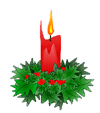
Christmas candles are all shapes, colors, sizes and scents. On the Advent wreath, a candle is lit each week to remind us of the coming of Christ. Candles represent Jesus who is the light of the world.
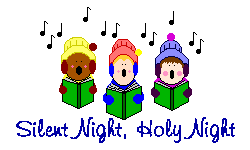
When St. Francis of Assisi created the first "creche" or Nativity (manger) scene, he and others sang the first carols. Most carols were handed down by word of mouth for hundreds of years. Most of the early carols were about Mary, the shepherds, the Magi and the birth of Jesus . Later carols were sung by groups of people who would go to homes and sing in harmony.
The Christmas star announced the birth of Christ. Many songs were written about it. The star appeared on many of the first Christmas cards in the 1840s. Stars were placed on the tops of Christmas Trees. CHRISTMAS STAR

Evergreen trees and tree branches have been used for decorating homes for Christmas. The decorated tree originated in Germany where a fir tree was decorated with apples and candles. Prince Albert brought the custom to England. The idea of decorating a Christmas tree spread to America.

The day of gift-giving varies in different countries .... Dec.6th (St.Nicholas day) ; Dec. 24th ; Dec. 25th ; Dec. 26th (Boxing day) ; January 6th (Epiphany, Feast of the Wise Men, or the three Kings).The giver of the gifts is also varies in different countries. It could be the Christ Child, Kriss Kringle, Santa Claus, Father Christmas, Befana in (Italy), Babushka (Russia), the Magi or St. Nicholas. "Nisse" are Scandinavian elves who hide presents for children. Jultomten , a gnome brings gifts to children in Sweden.

Making gingerbread cookies and gingerbread houses is a popular activity during the Christmas season. Gingerbread cookies were used to decorate the tree in the early days. It is called gingerbread because of the "ginger" spice that is used in making the cookies. Gingerbread houses were first made in Germany. The gingerbread house was popular after the fairy tale of Hansel and Gretel became well-known.

Holly trees can be found around the world. It remains green during the winter so it is used for decorating. The holly wreath resembles the crown of thorns placed upon Christ's head. The berries represent his blood.
During the season of Advent the Jesse tree is decorated each week with ornaments that represent the Old Testament stories from Creation to the Birth of Jesus. The star is usually the last symbol placed on the top.
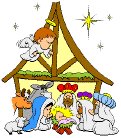
St. Francis of Assisi made the first manger scene on Christmas Eve in 1224 outside his church in Italy . He used real people and animals to recreate the scene. This idea soon spread. Some countries use wood carvings for the manger scene. Families in France set the creche on the fireplace or on a table. The child Jesus is not added to the manger until Christmas Eve. The Wise Men are added on January 6th, the day of the Epiphany (also called the Festival of the Kings) .

The first Christmas trees were decorated with real fruit and flowers. Cookies, nuts , candies and other kinds of food were added later on. Lighted candles were also used but there was the danger of fires when the candles were lit. Tiny gifts were also hung on the trees for ornaments. In Germany glass blowers began making glass balls to decorate the trees.
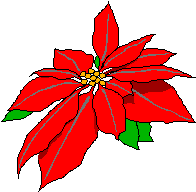
A legend in Mexico tells of a small boy who had nothing to offer the Christ Child on his birthday. As he prayed at the altar of a church, his prayers were answered and the "Flower of the Holy Night" sprang up before him. The bright red petals of the poinsettia are actually leaves. It originates in Mexico It was brought to the United States in the 1800s by a man named Dr. Poinsett and was named after him.The first plum puddings were made in the 1600s and were not even made of plums. The pudding was a "stiff" porridge to which was added lumps of meat, dried fruits, butter, sugar, eggs, spices, rum and brandy. It was prepared weeks before Christmas. PLUM PUDDING

- The Dutch were the first to speak of a merry old man in red and white clothes, with eight flying reindeer. He lived near the North Pole, filled stockings with presents, and came down the chimney. They called him Sinte Klass.
- When Moore wrote the poem "Twas the Night before Christmas", Santa Claus became popular in America.
- St. Nicholas was a bishop who gave money to the needy. In many countries he is the one who brings gifts. He is honored on Dec.6th.
- Father Christmas is known as an old man with a beard, dressed in a fur costume. Children in Finland wait for him to arrive on Christmas Eve.
- In France Pere Noel is a kindly old man who travels through the countryside on Christmas Eve and leaves gifts in "sabots" or wooden shoes.
- The Scandinavians have a Christmas elf dressed in a red suit and long white beard. He is called Julenisse. He brings gifts for the children.
There are many stories about this man who gave to the poor. It is said that he stopped storms at sea; he got grain to feed the hungry; and he performed miracles. One story tells of how St. Nicholas dropped gold down a poor man's chimney. The gold fell into the stockings which were hung by the fireplace to dry.The Feast of St. Nicholas is held every year in Bari (southern Italy) where he is buried. A statue of the saint is carried out to sea by boat. When the boats return to shore much celebrating takes place.
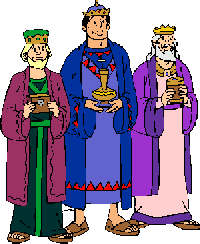
C.M.B. are the initials of the three Wise Men named Caspar, Melchior, and Balthazar. It is a custom in Poland, Czechoslovakia and Sweden for three boys to visit homes on the Epiphany. The initials C.M.B. are written over the doors of the homes and three crosses are drawn, also. This will bring good fortune in the new year to the people who live there.In the New Testament St.Matthew mentions the Three Wise Men or Magi who followed the star to Bethlehem. The oldest, Mechoir (King of Arabia) had a long gray beard. He gave gold as a gift for Christ. Balthazar (King of Ethiopia) was also bearded. He brought the gift of frankincense. Caspar (King of Tarsus) who was the youngest brought the gift of myrrh. It is said that after the Magi returned home they gave their belongings to the poor and went out to spread the Good News. They died as martyrs.
In early days fire was a symbol of the home, safety and warmth. The English took on the custom of burning the yule log on Christmas Eve. It was considered good luck to sit on it before it was burned and it was bad luck if the fire went out quickly. After the holidays had ended (twelve days of Christmas) a piece of the log was saved to rekindle the next year's log.


More about the Jesse Tree
Santa's Net Christmas Symbols
Christmas Customs and Traditions
more about symbols and traditions -
claus.com
J.Giannetta
jgiannet@hotmail.com
updated 2011